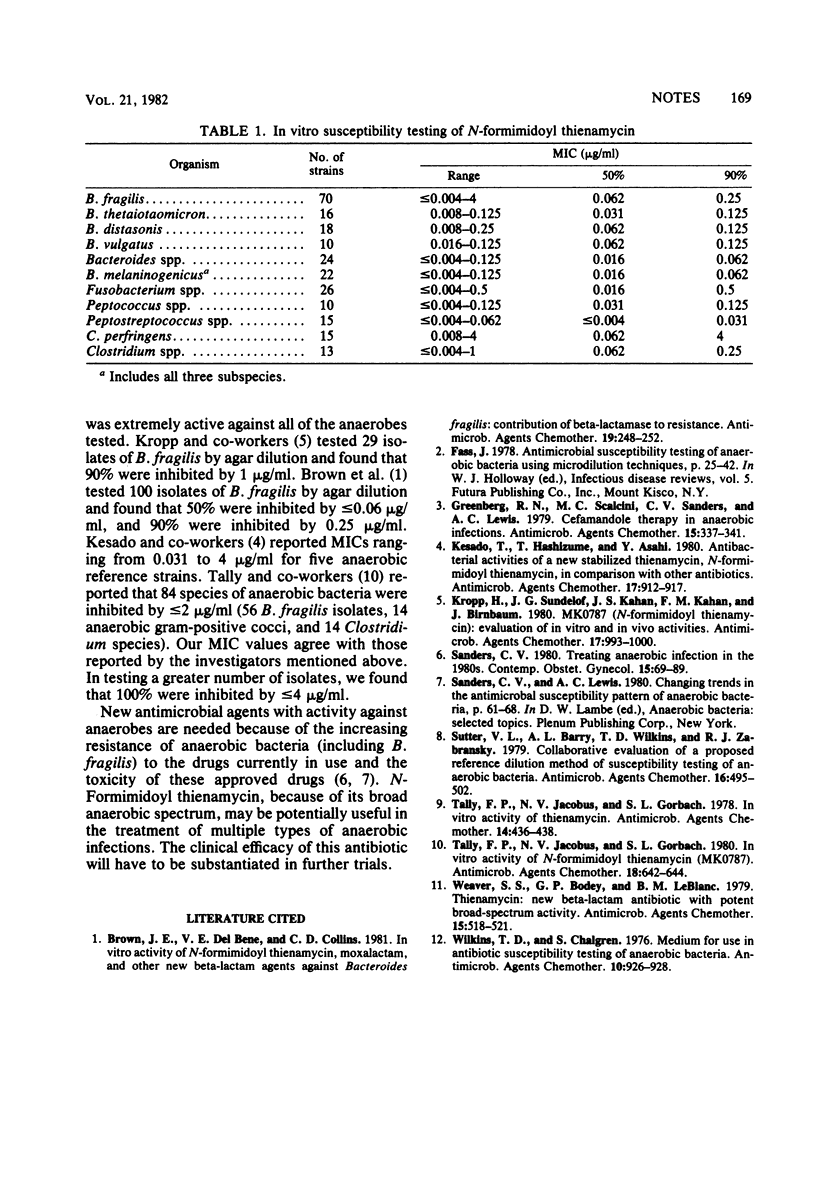Abstract
The in vitro activity of N-formimidoyl thienamycin (MK0787) was tested against 239 anaerobic bacteria clinical isolates: 70 of Bacteroides fragilis, 18 of B. distasonis, 16 of B. thetaiotaomicron, 10 of B. vulgatus, 24 of Bacteroides spp., 22 of B. melaninogenicus (all three subspecies), 26 of Fusobacterium spp., 10 of Peptococcus spp., 15 of Peptostreptococcus spp., 15 of Clostridium perfringens, and 13 of Clostridium spp. Ninety-five percent of the isolates were inhibited by less than or equal to 0.125 microgram/ml, and all were inhibited by less than or equal to 4 micrograms/ml.
Full text
PDF

Selected References
These references are in PubMed. This may not be the complete list of references from this article.
- Brown J. E., Del Bene V. E., Collins C. D. In vitro activity of N-formimidoyl thienamycin, moxalactam, and other new beta-lactam agents against Bacteroides fragilis: contribution of beta-lactamase to resistance. Antimicrob Agents Chemother. 1981 Feb;19(2):248–252. doi: 10.1128/aac.19.2.248. [DOI] [PMC free article] [PubMed] [Google Scholar]
- Greenberg R. N., Scalcini M. C., Sanders C. V., Lewis A. C. Cefamandole therapy in anaerobic infections. Antimicrob Agents Chemother. 1979 Mar;15(3):337–341. doi: 10.1128/aac.15.3.337. [DOI] [PMC free article] [PubMed] [Google Scholar]
- Kesado T., Hashizume T., Asahi Y. Antibacterial activities of a new stabilized thienamycin, N-formimidoyl thienamycin, in comparison with other antibiotics. Antimicrob Agents Chemother. 1980 Jun;17(6):912–917. doi: 10.1128/aac.17.6.912. [DOI] [PMC free article] [PubMed] [Google Scholar]
- Kropp H., Sundelof J. G., Kahan J. S., Kahan F. M., Birnbaum J. MK0787 (N-formimidoyl thienamycin): evaluation of in vitro and in vivo activities. Antimicrob Agents Chemother. 1980 Jun;17(6):993–1000. doi: 10.1128/aac.17.6.993. [DOI] [PMC free article] [PubMed] [Google Scholar]
- Sutter V. L., Barry A. L., Wilkins T. D., Zabransky R. J. Collaborative evaluation of a proposed reference dilution method of susceptibility testing of anaerobic bacteria. Antimicrob Agents Chemother. 1979 Oct;16(4):495–502. doi: 10.1128/aac.16.4.495. [DOI] [PMC free article] [PubMed] [Google Scholar]
- Tally F. P., Jacobus N. V., Gorbach S. L. In vitro activity of N-formimidoyl thienamycin (MK0787). Antimicrob Agents Chemother. 1980 Oct;18(4):642–644. doi: 10.1128/aac.18.4.642. [DOI] [PMC free article] [PubMed] [Google Scholar]
- Tally F. P., Jacobus N. V., Gorbach S. L. In vitro activity of thienamycin. Antimicrob Agents Chemother. 1978 Sep;14(3):436–438. doi: 10.1128/aac.14.3.436. [DOI] [PMC free article] [PubMed] [Google Scholar]
- Weaver S. S., Bodey G. P., LeBlanc B. M. Thienamycin: new beta-lactam antibiotic with potent broad-spectrum activity. Antimicrob Agents Chemother. 1979 Apr;15(4):518–521. doi: 10.1128/aac.15.4.518. [DOI] [PMC free article] [PubMed] [Google Scholar]
- Wilkins T. D., Chalgren S. Medium for use in antibiotic susceptibility testing of anaerobic bacteria. Antimicrob Agents Chemother. 1976 Dec;10(6):926–928. doi: 10.1128/aac.10.6.926. [DOI] [PMC free article] [PubMed] [Google Scholar]


